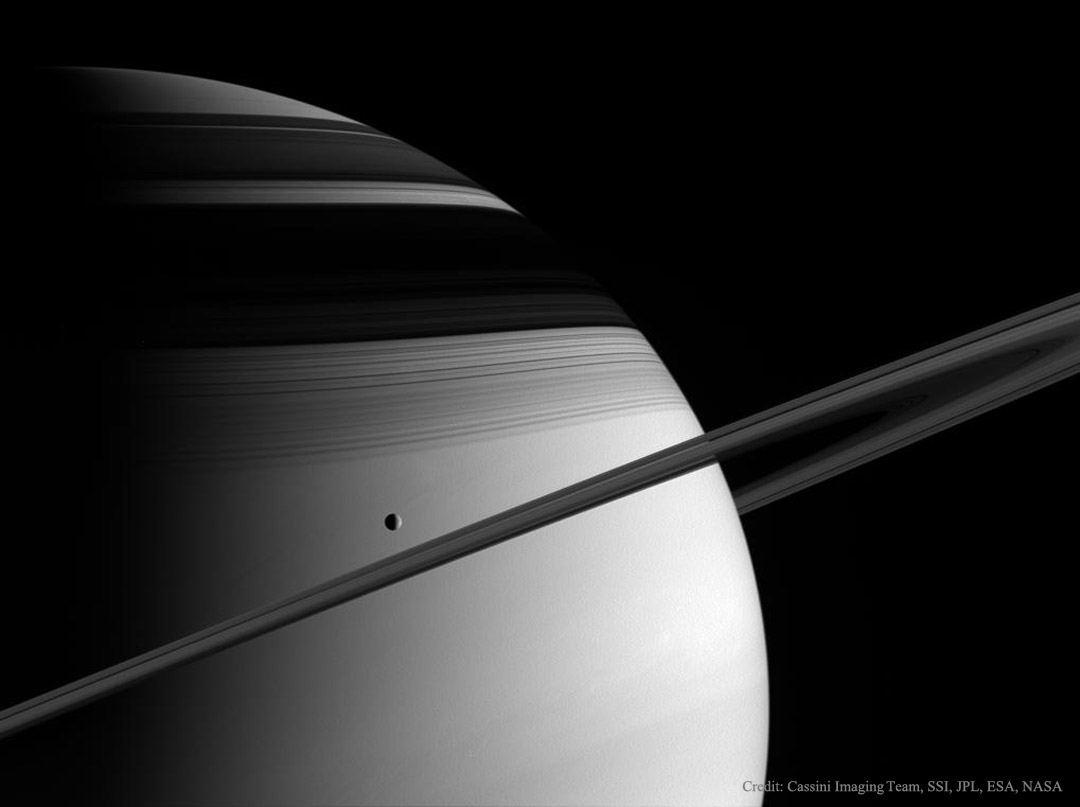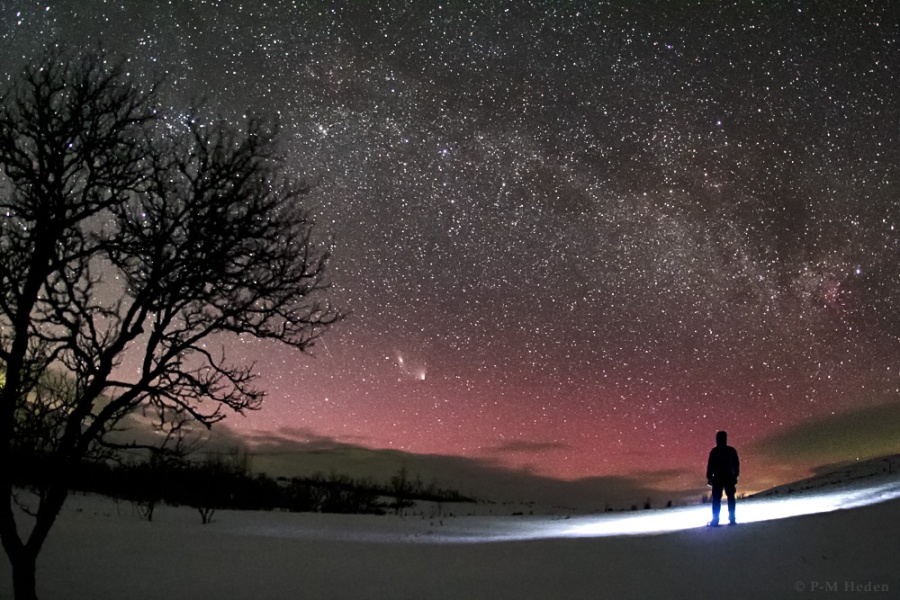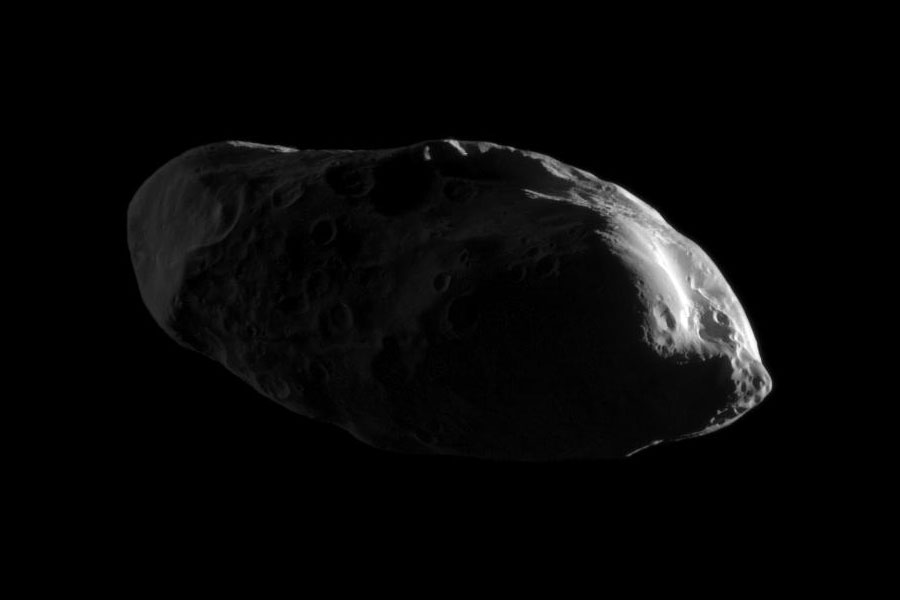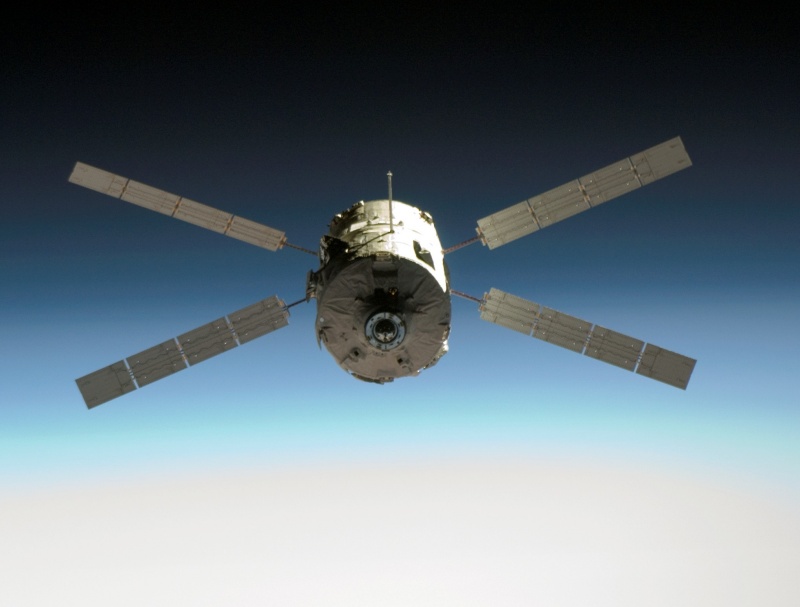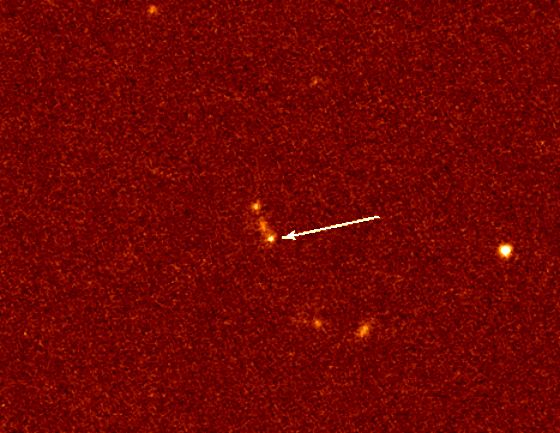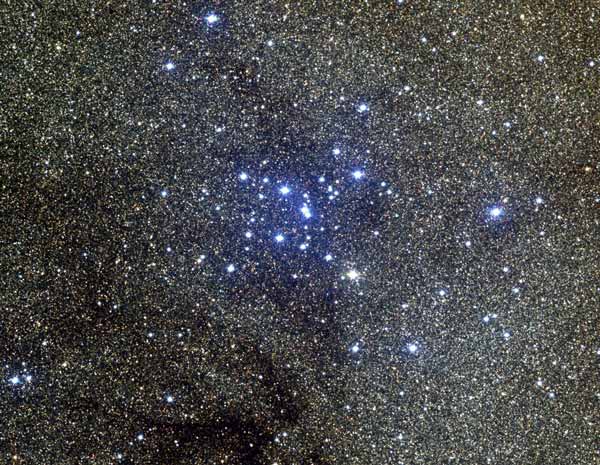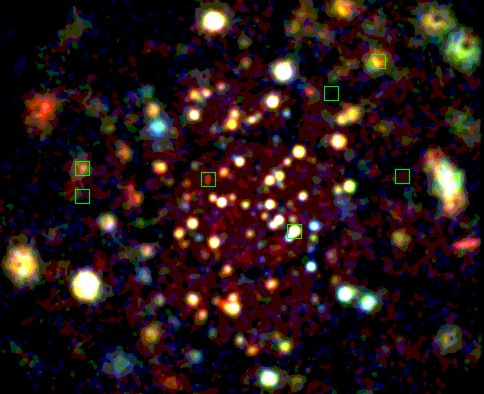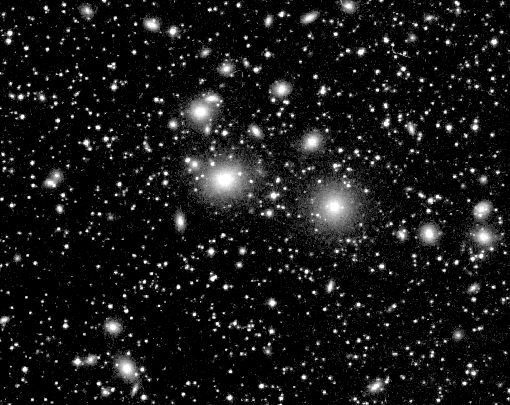| << Previous | Index | Next >> |
2015 Seen from ice moon Tethys, rings and shadows would display fantastic views of the Saturnian system. Haven't dropped in on Tethys lately? Then this gorgeous ringscape from the Cassini spacecraft will have to do for now. Caught in sunlight just below and left of picture center in 2005, Tethys itself is about 1,000 kilometers in diameter and orbits not quite five saturn-radii from the center of the gas giant planet. At that distance (around 300,000 kilometers) it is well outside Saturn's main bright rings, but Tethys is still one of five major moons that find themselves within the boundaries of the faint and tenuous outer E ring. Discovered in the 1980s, two very small moons Telesto and Calypso are locked in stable locations along Tethys' orbit. Telesto precedes and Calypso follows Tethys as the trio circles Saturn.
2014 Tidally locked in synchronous rotation, the Moon always presents its familiar nearside to denizens of planet Earth. From lunar orbit, the Moon's farside can become familiar, though. In fact this sharp picture, a mosaic from the Lunar Reconnaissance Orbiter's wide angle camera, is centered on the lunar farside. Part of a global mosaic of over 15,000 images acquired between November 2009 and February 2011, the highest resolution version shows features at a scale of 100 meters per pixel. Surprisingly, the rough and battered surface of the farside looks very different from the nearside covered with smooth dark lunar maria. The likely explanation is that the farside crust is thicker, making it harder for molten material from the interior to flow to the surface and form the smooth maria.
2013 It looks like a double comet, but Comet PanSTARRS (C/2011 L4) is just offering skygazers a Messier moment. Outward bound and fading in this starry scene, the well-photographed comet is remarkably similar in brightness to M31, the Andromeda Galaxy. Tracking through northern skies just below the galaxy, the comet was captured as local midnight approached on April 3. Both comet and galaxy were visible to the eye and are immersed in the faint glow of northern lights. Our own Milky Way galaxy arcs over the snowy field near Tänndalen, Sweden. Double star cluster h and chi Persei can be spotted along the Milky Way's arc high above the comet/galaxy pair. Follow the arc to bright Deneb, alpha star of the constellation Cygnus, at the right edge of the frame.
2012
2011
[imghover6=http://apod.nasa.gov/apod/image/1104/te ... o_1726.jpg]http://apod.nasa.gov/apod/image/1104/te ... d_1726.jpg[/imghover6]Credit & Copyright: Juan Carlos Casado (TWAN)
2010 What does Saturn's shepherd moon Prometheus really look like? The raw images from the robotic Cassini spacecraft's January flyby of the small moon showed tantalizing clues on grainy images, but now that the Cassini team has digitally remastered these images, many more details have come out. Pictured above, Prometheus more clearly shows its oblong shape as well as numerous craters over its 100-kilometer length. In the above image, the bright part of Prometheus is lit directly by the Sun, while much of the dark part is still discernible through sunlight first reflected off of Saturn. These new surface details, together with the moon's high reflectivity, can now help humanity better understand the history of Prometheus and Saturn's rings. Today, Cassini has a planned targeted flyby of Saturn's largest moon Titan, while on Wednesday, Cassini is scheduled to swoop to within 600 kilometers of Dione.
2009
Click to play embedded YouTube video.
Credit: Bruno Sánchez-Andrade Nuño et al. (IAG & MPS, NRL)
2008 The bright edge of planet Earth fades into the darkness of space in the background of this view of Jules Verne on an extraordinary voyage. Snapped last Monday, the picture shows the European Space Agency's Automated Transfer Vehicle (ATV), named for the 19th century science fiction writer and visionary, rehearsing its autonomous docking capability on approach to the International Space Station. Using a laser guided rendezvous system, the Jules Verne docked smoothly and safely with the orbiting station on Thursday, delivering 7,500 pounds of equipment, supplies, and fuel. The cylindrical body of the robotic cargo spacecraft is 4.5 meters in diameter and 10.3 meters long, with solar arrays spanning 22.3 meters. Jules Verne is scheduled to remain docked until August, providing a reboost for the space station before the ATV is deorbited.
2007 Apollo class asteroid 2006 VV2 flashed past planet Earth in late March, approaching to within 3.4 million kilometers or about 8.8 times the Earth-Moon distance. Due to the proximity of its orbit to Earth and its estimated diameter of over 1 kilometer, 2006 VV2 is classified as a Potentially Hazardous Asteroid. Telescopes large and small were trained on the much anticipated flyby, the closest for a known asteroid of comparable size until the year 2036. This composite telescopic view is from a series of images recorded over a period of about an hour on Mar. 28 from Vado, New Mexico. The asteroid begins near the center of the field and tracks down and to the left, apparently passing very near galaxy M81. Of course, along with its companion galaxy M82 on the right, M81 is really 12 million light years away, compared to the asteroid's range of a mere 15 light seconds.
2006 When orbiting Saturn, be sure to watch for breathtaking superpositions of moons, rings, and shadows. One such picturesque vista was visible recently to the robot Cassini spacecraft now orbiting Saturn. In late February, Cassini captured Rhea, the second largest moon of Saturn, while looking up from slightly beneath Saturn's expansive ring plane. Signature dark gaps are visible in the nearly edge-on rings. A shadow of Saturn's F ring cuts across the cratered ice-moon. Cassini is scheduled to continue sending back images from the orbit of Saturn until at least 2008.
2005 Light emitted by a planet far beyond our Solar System has been identified for the first time. The planet, illustrated in the above drawing, had its light detected by comparing the brightness of only the parent star, when the planet was behind the star, to the light emitted when both the planet and its parent star were visible. The Earth-trailing Spitzer Space Telescope made the observation in infrared light, where the intrinsic glow of the planet outshines the light it reflects from its central star. The direct observation of light allowed a measurement of both the temperature and size of the planet: HD 209458b. Planet HD 209458b was confirmed to be larger than expected for its mass and on an orbit around its parent star that was unexpectedly close to a circle.
2004 How were these unusual Martian spherules created? Thousands of unusual gray spherules, made of iron and rock but dubbed blueberries, were found embedded in and surrounding rocks near the landing site of the robot Opportunity rover on Mars. To help investigate their origin, Opportunity found a surface dubbed the Berry Bowl with an indentation that was rich in the Martian orbs. The Berry Bowl is pictured above, imaged during rover's 48th Sol on Mars. The average diameter of a blueberry is only about 4 millimeters. By analyzing a circular patch in the rock surface to the left of the densest patch of spherules, Opportunity obtained data showing that the underlying rock has a much different composition than the hematite rich blueberries. This information contributes to the growing consensus is that these small, strange, gray orbs were slowly deposited from a bath of dirty water.
2003 Since Saturn's axis is tilted as it orbits the Sun, Saturn has seasons, like those of planet Earth ... but Saturn's seasons last for over seven years. So what season is it on Saturn now? Orbiting the equator, the tilt of the rings of Saturn provides quite a graphic seasonal display. In fact, this month, Saturn's rings will reach their most "open" angle after appearing nearly edge on in the mid-1990s. The ringed planet is also well placed in evening skies providing a grand view as summer comes to Saturn's southern hemisphere and winter to the north. The Hubble Space Telescope took the above sequence of images about a year apart, starting on the left in 1996 and ending on the right in 2000. Although they look solid, Saturn's Rings are likely less than 50 meters thick and consist of individually orbiting bits of ice and rock ranging in size from grains of sand to barn-sized boulders.
2002
2001 Where did the gold in your jewelry originate? No one is completely sure. The relative average abundance in our Solar System appears higher than can be made in the early universe, in stars, and even in typical supernova explosions. Some astronomers now suggest that neutron-rich heavy elements such as gold might be most easily made in rare neutron-rich explosions such as the collision of neutron stars. Pictured above is a computer-animated frame depicting two neutron stars spiraling in toward each other, just before they collide. Since neutron star collisions are also suggested as the origin of gamma-ray bursts, it is possible that you already own a souvenir from one of the most powerful explosions in the universe.
2000 M7 is one of the most prominent open clusters of stars on the sky. The cluster, dominated by bright blue stars, can be seen with the naked eye in a dark sky in the tail of the constellation of Scorpius. M7 contains about 100 stars in total, is about 200 million years old, spans 25 light-years across, and lies about 1000 light-years away. This color picture was taken in 1995 at the Burrell-Schmidt Telescope at Kitt Peak National Observatory in Arizona. The M7 star cluster has been known since ancient times, being noted by Ptolemy in the year 130 AD. Also visible is a dark dust cloud near the bottom of the frame, and literally millions of unrelated stars towards the Galactic center.
1999 NASA launches powerful rockets. One such rocket, the Delta II, recently lofted the STARDUST mission into the nearby Solar System. STARDUST is expected to photograph Comet Wild in 2004 as it zooms by, and return interstellar dust samples to Earth in 2006. Currently, much remains unknown about the size distribution, primordial composition, and even shapes of these dust grains. Above, a side-mounted camera photographed the separation of the solid rocket boosters above the receding Earth.
1998 The Pleiades star cluster is one of the jewels of the northern sky. To the unaided eye it appears as a lovely and tantalizing grouping of stars in the constellation of Taurus, while telescopic views reveal cluster stars surrounded by delicate blue wisps of dust-reflected starlight. To the X-ray telescopes on board the orbiting ROSAT observatory, the cluster also presents an impressive, but slightly altered, appearance. This false color image was produced from ROSAT observations by translating different X-ray energy bands to visual colors - the lowest energies are shown in red, medium in green, and highest energies in blue. (The green boxes mark the position of the seven brightest visual stars.) The Pleiades stars seen in X-rays have extremely hot, tenuous outer atmospheres called coronas and the range of colors corresponds to different coronal temperatures.
1997 The center of nearby giant galaxy M87 is a dense and violent place. In this 1994 photograph by the Hubble Space Telescope, a disk of hot gas was found to be orbiting at the center of this massive elliptical galaxy. The disk is evident at the lower left of the picture. The rotation speed of gas in this disk indicates the mass of the object the gas is orbiting, while the size of the disk indicates an approximate volume of the central object. These observations yield a central density so high that the only hypothesized object that could live there is a black hole. The picture also shows a highly energetic jet emanating from the central object like a cosmic blowtorch. The jet is composed of fast moving charged particles and has broken into knots as small as 10 light years across.
1996 Here is one of the largest objects that anyone will ever see on the sky. Each of the fuzzy blobs in the above picture is a galaxy, together making up the Perseus Cluster, one of the closest clusters of galaxies. We view the cluster through the foreground of faint stars in our own Milky Way galaxy. It takes light roughly 300 million years to get here from there, so we only see this cluster as it existed during the age of the dinosaurs. Also known as Abell 426, the center of Perseus cluster is a prodigious source of X-ray radiation, and so helps us study how clusters formed and how gas and dark matter interact. The Perseus Cluster of Galaxies is part of the Pisces-Perseus supercluster of galaxies, which spans over 15 degrees and contains over 1000 galaxies.
| << Previous | Index | Next >> |
